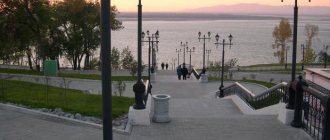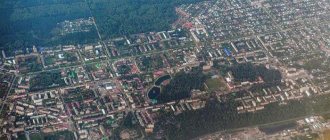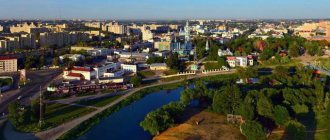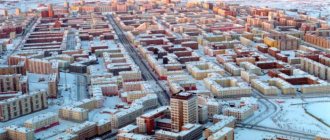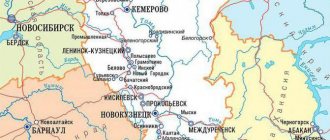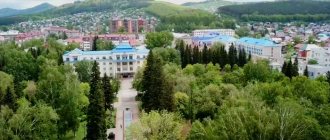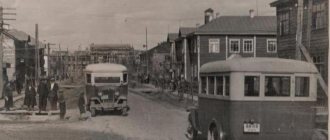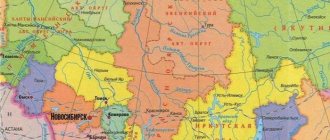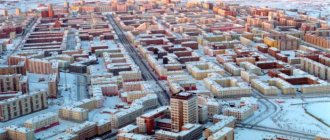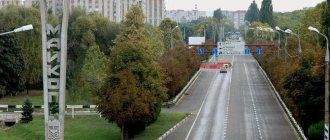Quick acquaintance
The settlement was founded in the second half of the 19th century. Last year, the city of Ussuriysk celebrated its hundred and fiftieth anniversary. Its first inhabitants came from the Voronezh and Astrakhan provinces. Later they were joined by representatives of the Ukrainian diaspora. The city acquired a characteristic Little Russian flavor. Until 1957, the settlement was called Voroshilov.
Today Ussuriysk is considered an important railway junction. There is a locomotive repair plant operating there. The city's architectural ensemble is represented by buildings erected at the end of the 19th century. Archaeological excavations are actively underway in the vicinity of the municipality.
There are practically no attractions. The exception is the monument to an ancient steam locomotive, which is installed near the railway station.
Economy
Ussuriysk is a large railway junction on the Trans-Siberian Railway. In the city there are: Ussuriysk Locomotive Repair Plant - a large enterprise that repairs locomotives for the needs of Russian Railways and industrial enterprises, food industry enterprises (sugar, dairy, distillery factories), mechanical engineering factories, there are enterprises for sewing clothing and leather shoes, construction industry, oxygen plant, furniture factory, cardboard plant.
The volume of shipped goods of own production, work and services performed in-house in manufacturing industries in 2009 amounted to 7.27 billion rubles.
Geographical position
The landscape of the territory occupied by the city is flat. The local lands are distinguished by a large supply of fresh water. In their depths lies a huge underground lake. The municipality is surrounded by mountain ranges on the slopes of the Sikhote-Alin complex. Where Ussuriysk is located, small mountain streams flow. The longest is Suifun (Razdolnaya). The length of its channel exceeds 247 kilometers. Rakovka divides the city into two parts. It originates on the outskirts of the Ussuri Nature Reserve.
A few minutes' drive from the city are the Komarovka, Slavyanka, and Borisovka rivers. Their length does not exceed 90 kilometers. Almost all of them begin their journey in the mountains of the reserve; some belong to the Razdolnaya hydrological system. In summer they become shallow, forming sandy islands. In the midst of spring downpours, once-peaceful rivers become obstinate and capricious. Seething and hissing, they carry in their icy waters trunks of uprooted trees and boulders of stone.
Transport accessibility
The city occupies a strategically important position. It serves the only railway line connecting the western regions of Russia with the Primorsky Territory and Asian countries. The developed infrastructure of the city is explained by the presence of two border crossings. One is located in Grodekovo near the border with China. The other is located in Kraskino and leads to the DPRK.
Where Ussuriysk is located, the largest highway in the Primorsky Territory is laid. The length of that part of Ussuri, which occupies the territory of the region, is almost forty kilometers. The nearest settlements are Vladivostok, Pogranichny and Arsenyev. They are approximately two hours away by car.
In the vicinity of the municipality, the path leading from the administrative center to the Chinese city of Suifenhe begins. The total length of all highways exceeds 830 kilometers. The regional administration plans to build new transport interchanges. Where Ussuriysk is located, a federal bypass road will appear in a few years. It will relieve congestion on the main route.
Commemorative steam locomotive El-629
At the Ussuriysk railway station there is a locomotive that took an active part in the events of the First World War and the Civil War. And it was manufactured overseas, at the American Baldwin plant. According to one version (most likely untrue), “fighters for Soviet power” Sergei Lazo, Alexey Lutsky and Vsevolod Sibirtsev were burned in the firebox of this locomotive in 1920.
Demographic situation
According to statistics, in 2022 more than 170,000 people were registered in the city. The number of residents is gradually increasing. Five years ago, 165,000 were registered in the municipality. A decline in the birth rate and a decrease in population in Ussuriysk was observed in the period from 2005 to 2009. Starting from 2010, the demographic situation began to gradually stabilize.
In 2014, the settlement took 110th position in the general ranking of cities in the Russian Federation, based on the total number of residents. The number of children born per thousand of the population is 12 people. True, the mortality rate is also growing. Doctors explain this by the poor environmental situation in the region. After all, where Ussuriysk is located, there are a lot of industrial enterprises operating. The mortality rate in 2011 reached 18 people per 1,000.
Minors make up about 19%, adults under the age of 55 account for 55%, and pensioners make up 25% of the total number of residents. Six out of ten children attend preschool institutions. In 2011, thirty secondary schools operated in the settlement. The national composition of the population of Ussuriysk is represented by Russians, Ukrainians, immigrants from Korea and representatives of other diasporas.
Ussuri temples
It is impossible to imagine the rating of interesting places in Ussuriysk without religious buildings. There are not too many churches here, but each of them is remarkable in its own way.
Church of the Intercession
- Opening hours: daily, from 7:00 to 19:00.
- Telephone.
- Website: https://pokrovus.cerkov.ru
- Address: st. Chicherina, 80A. Transport stop "Market".
The oldest church in the city, consecrated in the fall of 1914, was built on the site of the first church of the then Nikolsky, which had existed since 1871. For forty years, the wooden structure had fallen into disrepair and needed replacement. The new building was erected from stone in an eclectic style, characteristic of Russian religious architecture of the late 19th century. During the Soviet era, the temple was subjected to repression. It was closed and converted first into a pioneer camp building, and then into a warehouse. Only in the summer of 1946 did the authorities return the building, which was already in a deplorable state, to the diocese. By the way, Japanese prisoners of war took part in the restoration of the church. Today, the architectural monument, which recently celebrated its centenary, is one of the iconic sights of Ussuriysk.
St. Nicholas Church
- Opening hours: daily, from 7:00 to 19:00.
- Telephone.
- Website: https://ussur-nikola.cerkov.ru
- Address: st. Komarova, 58. Transport stop “Komarov Street”.
Once upon a time, the majestic St. Nicholas Cathedral, whose gilded cross cut 51 meters into the sky, was considered the main decoration of Ussuriysk. However, the atheist Bolsheviks did not spare the old regime architectural monument. A terrible explosion that thundered over the city on a May day in 1934 destroyed the building to the ground. The parishioners had to wait more than 70 years for the restoration of historical justice. The year 2009 was marked by a joyful event for them. Then the ceremony of consecrating the new St. Nicholas Church on Komarova Street took place. Of course, the white stone church is smaller in size than its predecessor and bears little resemblance to it in appearance. But this does not detract from the joy of the Orthodox. Secular tourists, in turn, are happy to take pictures against the backdrop of the temple, in the exterior of which one can discern features characteristic of both the cathedrals of Yaroslavl or Vladimir , and Veliky Novgorod .
Church of Seraphim of Sarov
- Opening hours: daily, from 7:00 to 19:00.
- Telephone.
- Address: st. Slobodskaya, 7A. Transport stop "PGSHA".
At the beginning of the new century, Ussuriysk found another temple, consecrated at the end of December 2003 in the name of the great saint of the Russian land, Seraphim of Sarov. Funds for construction were allocated by city organizations and philanthropic patrons. The small and very cozy church immediately attracts the eye. The nature of this magnetism is not difficult to explain. Travelers' attention is attracted by the unusual shape of the bell tower. It's like it's double. In addition, two blue domes rise above the colorful building attached to the main volume. Such an architectural technique is completely uncharacteristic of traditional religious architecture.
Meteorology
The municipality stretches along the southeastern part of the Khanka Valley. The climate in these parts is monsoon. Open spaces, into which Nordic winds easily penetrate, cause frosty and cold winters. Icy continental air masses arrive in the region from the center of Russia. They are formed under the influence of a powerful Siberian anticyclone.
In January, the thermometer in the city of Ussuriysk and its environs remains at -20 °C. But it can drop to -45 °C. The sky in the middle of winter is clear, there are almost no clouds. The sun is often bright. Winds during this period are rare guests in the region. They are weak and short-lived. Sometimes there are thaws. The total precipitation for all three months is 55 mm. The maximum height of snow cover in open areas reaches 20 centimeters.
In Ussuriysk and Primorsky Krai, spring begins in March. In the first half of the month, the frosts finally lose their grip. In April the thermometer shows 5 °C. The possibility of night frosts continues until the end of May. It rains frequently, but there are also relatively long periods of calm. They can last ten days in a row. Summer is accompanied by thick morning fogs. It rains from June to August. Humidity increases noticeably.
In Ussuriysk and Primorsky Krai the temperature in July reaches 21 °C. Maximum precipitation occurs in August. September can also be rainy. About 30 millimeters of moisture falls in the city per day, which leads to man-made disasters. Heavy and prolonged downpours wash away highways, destroy crops, and remove the top fertile soil layer. The influence of the monsoons ends in early October.
Theaters
To the Ussuri Drama Theater
from the Eastern Military District is located at Sovetskaya Street, 31. The theater was founded in 1937 and is one of two theaters of the Russian Army (the other is the Central Theater of the Russian Army in Moscow). [
citation needed
] The theater maintains a military-patriotic orientation and realism.
To the Ussuri Drama Theater
located at: Volodarsky Street, 33. Opened in 1937. [
citation needed
] Theater of classical styles.
Performances are staged for both adults and children. The hall seats 428 people.[ quote needed
]
Welcome!
According to tourists coming from Moscow to Ussuriysk, the best time of year in Primorye is autumn. It captivates with the golden brocade of foliage and the kaleidoscope of colors that decorate the slopes of the reserve. During this period the weather is excellent. The average daily temperature is lower than in summer, but higher than in spring. The sky is high and clear, and the sun is bright and radiant. The earth gives up its heat. The thermal regime is also influenced by the sea, which finally cools down only in December.
Society
Education and science
In Ussuriysk there is a Pedagogical Institute, an Agricultural Academy, an Institute of Railway Transport, and a number of secondary educational institutions. In addition, the city has the Suvorov Military School.
In the vicinity of the city there are the Primorsky Research Institute of Agriculture, the mountain taiga station of the Far Eastern Branch of the Russian Academy of Sciences, the Komarov Nature Reserve, the solar service of the Far Eastern Branch of the Russian Academy of Sciences - the easternmost astronomical observatory of Russia.
Healthcare
There are two hospitals in the city: city and railway, there is also a medical school and 6 clinics.
Difference in time
The time zone of Ussuriysk bears the international designation Vladivostok Time Zone. It includes not only this city, but also all settlements located in Primorye. The clock offset according to the international UTC system is +11:00. Time in this part of Russia differs from standard time by exactly one hundred and twenty minutes. There is a maternity leave zone in the region.
The difference between Moscow and Ussuriysk is seven hours. In our country, the belt is designated MSK+7. There is no change to daylight saving time. The UTC offset applies year-round. In winter, sunrise in the city occurs at 08:30 and sunset at 17:30. The average daylight hours are nine hours. Solar noon is celebrated at 13:00.
The time difference with Los Angeles is 18 hours, with New York 15, with London 10, with Paris 9, with Beijing 2, with Tokyo 1.
Crime
The criminal history of the city includes many incidents. Murders, robberies, assaults, fraud against people of retirement age, car theft, tax evasion - such crimes are unlikely to surprise anyone now. They happen not so often, but they attract attention and sometimes even shock city residents. Yes, what can I say, there is not a single city in Russia in which the criminal world does not operate. However, in Ussuriysk, the cause of many conflicts, which often end in tears, are fights on domestic grounds. Petty robberies, assaults and thefts occur mainly in residential areas of the city at night.
As in many Russian cities, the main problem in Ussuriysk is drunkenness. Every year the number of drunk drivers behind the wheel increases, and, as a result, the number of accidents with tragic outcomes. Traffic police officers regularly patrol the streets and conduct various operations aimed at reducing the number of drunk drivers.
In general, the situation in the city is under control of law enforcement agencies. And if you lead a healthy lifestyle and follow basic safety rules, then you will probably not cross paths with this dangerous and cruel world.
Nature
The region's resources are represented by deposits of hard and brown coal. The lands are rich in sorbents, diatomites, limestones, and building stones. Clay and sandy soils are found. Due to the monsoon climate of Ussuriysk, the local flora is strikingly different from that present in the central part of the continental regions.
There are more than eight hundred plant species in the region. Fifteen names are listed in the Red Book. In Primorye, ginseng is especially valued. They collect the muzzle, lady's slippers, and Clayton's cape.
Ussuriysk
Video: Ussuriysk
Basic moments
Ussuriysk, built by Russian people on the site of the ruins of a medieval Jurchen fortress, boasts more than 200 years of history. Artifacts and documents in the exhibitions of local museums, as well as ancient monuments preserved on the streets of the city can tell about it. In the historical center, which the townspeople call either the “Old Town” or the “New Arbat”, buildings from the late 19th – early 20th centuries have been preserved. The beautiful facades of the restored buildings, painted in pastel colors and decorated with turrets and spiers, look very attractive, giving the center of Ussuriysk the charm of the pre-revolutionary era.
The city has theaters, museums, cultural centers, and nightclubs. Local culinary establishments offer a variety of menus; tourists are especially attracted to restaurants specializing in Chinese and Japanese cuisine. The proximity of China is evidenced by the range of goods in local stores, and, of course, the famous Chinese market operating in the city center is one of the largest in Primorye.
Ussuriysk has several beautiful parks and clean lakes where you can sunbathe and swim in the summer. The city's surroundings are incredibly picturesque with their magnificent natural landscapes, coniferous and deciduous forests, and mountain rivers. Just 50 km from the city is the famous Ussuri Nature Reserve, home to rare species of animals, including the famous Ussuri tiger, and 70 km away is the Land of the Leopard Park.
From Ussuriysk, tourists can go on excursions to interesting places in Primorye, as well as take a trip to neighboring China.
Streets of UssuriyskHistory of Ussuriysk
The Khanka plain, where the Ussuri urban district is located, was inhabited by people in prehistoric times. Archaeologists discovered the remains of their dwellings, as well as simple tools, both within the modern city and in its environs. It is known that in the 12th-10th centuries these lands were part of the first Bohai state in Primorye, founded by the Tungus-Manchus. In the place where Ussuriysk is located today, there was the city of Suibin (or Shuaibin), which was the center of the province of the same name, famous for the breed of fleet-footed horses bred here.
The vast and prosperous state of Bohai, which had close ties with China and Japan, lasted a little more than two centuries. From Chinese chronicles we know that in 926 it fell under the pressure of the troops of the powerful Khitan-Mongol state of Liao. The city of Suibin was stormed and destroyed. In 1113, the Khitan-ruled Jurchen tribes, led by Khan Aguda, head of the Wanyan clan, rebelled, the center of which was the former province of the state of Bohai Suibin. In 1115, Aguda proclaimed the creation of the Golden Empire of Jin, and took the title of emperor. In 1125, the Liao state was defeated.
The city of Suibing, which became part of the Jin Empire, was restored and fortified. In Ussuriysk, the remains of two ancient fortifications of that time have been preserved; they are called the South Ussuri and West Ussuri settlements. Nearby, on a high hill, a mountain fortress was built. At the beginning of the 13th century, it was significantly expanded and, under the name Kaiyuan, became the capital of the Jurchen state that separated from the Jin Empire, known to historians as the Eastern Xia. Today, the remains of the fortress are an archaeological monument and a cultural heritage site of federal significance.
In 1233, Suibing and Kaiyuan were destroyed by hordes of Mongol-Tatars. At the beginning of the 18th century, French Jesuits, who, on the instructions of the Chinese Emperor Kangxi, carried out a topographic survey of a vast territory from the north of Korea to the mouth of the Amur, discovered the ruins of Suibin. They plotted the ruined city on a map (“Kangxi map”), labeling it Furdan. From there, Furdan “migrated” to other geographical maps, where it was found under this name until 1860.
In the 17th century, the first Russian settlements began to appear in Primorye, which, according to the Russian-Chinese Aigun Treaty, became part of the Russian Empire. In 1866, several families of immigrants from the Astrakhan and Voronezh provinces founded the village of Nikolskoye near the destroyed Jurchen city, but two years later it was burned by Chinese manzas who engaged in illegal gold mining and robbery. In 1870, by order of the Governor-General of Eastern Siberia, the village was rebuilt, and on the site of the ancient fortifications, barracks were built to house a military garrison, which later became one of the largest in Primorye.
The village quickly grew and developed, which was facilitated by its favorable location, fairly fertile soils and climate. In 1880, a road was built from Nikolskoye to Vladivostok, and three years later these settlements were also connected by rail. The population of Nikolskoye grew, and the village of Ketritsevo arose not far from it. In 1898, the village of Nikolskoye was united with Ketritsevo, and the authorities gave this administrative unit city status. The city was named Nikolsk-Ussuriysk, indicating in its name the name of the Ussuri Territory - a vast region in the Ussuri River basin. The river itself flows 150 km from the city.
In the 30s of the last century, after the occupation of Manchuria by Imperial Japan, the headquarters of the newly created Primorsky Group of Forces was located in Nikolsk-Ussuriysky. Obviously, in order to strengthen the special significance of this area and the city itself, the Soviet government adopted a document on the formation of a new region - Ussuriysk. Its center became Nikolsk-Ussuriysky, which in 1935 was renamed the city of Voroshilov. Since 1937, after the deportation of coastal Koreans to Central Asia and a wave of political repression, the Chinese living in the city began to leave it en masse, moving to the territory of their historical homeland. The city has lost its multi-ethnic appearance.
During the Great Patriotic War, the city of Voroshilov was in an ambivalent position: being far from the fighting in Europe, it nevertheless faced the threat of invasion from Japan, located very close by. The civilian population was ordered to regularly undergo military training, and townspeople took part in the construction of defensive structures. After the USSR entered the war with Japan, the railway station of the city of Voroshilov became a distribution center for the deployment of the 1st Far Eastern Front; the headquarters of the Primorsky Military District was located in the city. Soon after the end of World War II, hostilities broke out in Korea, the civil war resumed in China, and the border Voroshilov continued to serve as a military base. After the end of hostilities in China and the formation of the communist PRC, the city lost its strategic importance and returned to peaceful life, finding itself in the shadow of the dynamically developing Vladivostok. In 1957, it received its modern name - Ussuriysk.
Geography and climate
The city of Ussuriysk is located in the southwest of the Primorsky Territory, in the Prikhankai lowland - the most extensive flat territory of Primorye. It is located in a hollow between low 100-meter hills, in a bend of the Razdolnaya River, at the confluence of the Rakovka and Komarovka rivers. To the west of Ussuriysk there are spurs of the East Manchurian mountain system, bordering the Khanka Plain. In the east rise the spurs of the Przhevalsky Mountains, in their southern part, in the upper reaches of the Komarovka River, the Ussuri State Nature Reserve is located.
Geographically, Ussuriysk is located very well. Most of the significant settlements of Primorye are no more than two hours away, including Vladivostok, Arsenyev, Pogranichny, Spassk-Dalniy.
Ussuriysk is an important transport hub of strategic importance for the entire Far Eastern region of the Russian Federation. Through the railway stations of the Ussuri urban district, which are links of the Trans-Siberian Railway, trade flows between the seaports of Primorye and the European part of Russia. Highways leading from ports inland and highways to Vladivostok and Khabarovsk also pass through Ussuriysk. A regional highway connects the city with the Border Region, beyond which the territory of the People's Republic of China begins. The distance from Ussuriysk to the regional center Pogranichny is 98 km.
Ussuriysk is separated from Moscow by 9064 km (along the highway). The time is 7 hours ahead of Moscow.
Spread over a vast, windswept valley, Ussuriysk fully feels the proximity of the Sea of Japan and the Pacific Ocean. In winter, northern and northwestern winds bring cold air from the Siberian expanses of the mainland, and in summer, thanks to the southern wind blowing from the sea, warm weather with high humidity sets in.
The coldest months are December and January, when the air temperature drops to -15...-10 °C. In February, temperatures are already higher, and there are often thaws. Snow falls infrequently, the weather is usually clear. Spring in Ussuriysk is late, windy, this time of year threatens frosts until mid-May.
In the first half of summer it is still cool, about +18...+20 °C, cloudy, and often drizzling. At night the city is covered in thick clouds. In the second half of July and August it becomes warm, sometimes even hot - up to +30 ° C, and it rains often. With the beginning of autumn, when the southern monsoon weakens, clear weather sets in. In September it is much warmer here than in June, and this is the best time to visit Ussuriysk. The first half of October also brings joy with sunny, warm days. Then frosts begin, and in the second ten days of November stable frosty weather sets in.
Districts of Ussuriysk
Ussuriysk stretches along the left bank of the Razdolnaya River; it is clearly divided into eastern and western parts by the railway track and the Razdolnaya tributary, the Rakovka River. There is no official division into districts in the city, but it is quite convenient to navigate here by the names of the main streets. At the same time, in everyday life, Ussurians often use general names for various districts that arose in connection with the historical development of the city.
The center of the city, and this is its western part, is considered to be a “square” formed by the streets of Pushkin, Lenin, Nekrasov, Oktyabrskaya and the streets adjacent to them. The corner where the historical buildings of the late 19th – early 20th centuries have been preserved is called the “Old Town”. Here are administrative buildings, the main city square, major shopping centers, and offices of large commercial and industrial companies.
To the south of the center is the region of the Seven Winds, so named apparently because of its location in an open area with wind from all directions. The area lies between Rakovka and Soldatskoye Lake. There are many new buildings here, as well as in Slobodka, located on the opposite bank of Rakovka, near the railway. The center, Seven Winds and Slobodka are considered very prosperous areas, in contrast to the residential and outlying areas, where robberies, robberies, “drunken” fights and other unpleasant incidents often occur. Tourists on the city outskirts have nothing to do in the evenings.
To the north of Slobodka is the Mezhdurechye district, which received this name due to the fact that it is located between two small rivers - Rakovka and Komarovka. Not far from it there is a lake where beautiful lotuses bloom every summer.
In the southeast of Ussuriysk there is the village of Sakharny, a small industrial area. Its name was given by the largest sugar production plant in the Far East of the Russian Federation located here.
Recently, microdistricts with beautiful cottages and mansions built by wealthy citizens have grown up around Ussuriysk.
Sights and museums
Ussuriysk is not distinguished by the variety of architectural monuments, but in the “Old Town”, in the area of Kalinin and Timiryazev streets, many beautiful, solid pre-revolutionary buildings have been preserved. Among them are the building of a real school, the Ussuri Post Office - an architectural monument that previously housed a trade school, the building of the Trading House "Churin and Co", also known as the "old GUM", the house of the merchant Ryabokon. The building of the Ussuri Military Hospital, which dates back to 1883, is also an architectural monument.
The architectural landmark of the city is the former shopping arcade, built during the times of the Russian Empire by the German partnership Kunst and Albers. Today, within the walls of this ancient building there is a café “Boulevard”, a grocery store and a military registration and enlistment office. In the former People's House, built with funds from the pre-revolutionary “vodka kings” of the Far East, the Pyankov brothers, today there is a drama theater named after. Vera Komissarzhevskaya.
In the city center, not far from the bus station, there is a beautiful stone Church of the Intercession of the Holy Virgin - the oldest church in Ussuriysk. It was built in 1871 on the site of the first wooden church in the village of Nikolskoye. Although this temple was built in the traditions of Orthodox church architecture of the late 19th century, the decor of its interiors recognizes ancient artistic techniques and details characteristic of the architecture of the 17th century.
The religious buildings of the beginning of this millennium include the temple of Seraphim of Sarov, the Church of St. Nicholas the Wonderworker and the small temple of the Holy Great Martyr George the Victorious located next to it.
The oldest, most striking and unusual attraction of Ussuriysk is the Jurchen stone turtle - a historical monument dating back to the 12th-13th centuries. This archaic statue of a turtle, carved into a granite slab, was found during excavations on the territory of the fortifications of the medieval city of Suibin, carried out in the 60s of the last century. An identical granite turtle discovered during research was sent to a museum in Khabarovsk.
According to historians, the turtle, which personified eternity in the minds of the Jurchens, could have been a sacred element of the funeral complex of one of the Jurchen military leaders. This ancient monument can be seen in the city park DORA (House of Officers of the Russian Army).
It is interesting to look into the local history museum of Ussuriysk. It is located in a beautiful historic former parochial school building. Its small exhibition, which fits into three rooms, introduces visitors to the history of Ussuriysk, from the era of the Bohai state to the present.
In the center of Ussuriysk there is the Korean Cultural Center, one of the largest in Russia. Housed in a beautiful modern building, the museum displays historical documents and exhibits that clearly represent the uniqueness of Korean culture. In its spacious, bright rooms, equipped with the latest equipment, children of different nationalities are taught Korean and English, and there is an office where you can learn to play national Korean instruments. Holidays dedicated to the Lunar New Year, events for Remembrance Day (April 4-5), and the autumn Harvest Festival are held here. In the cafe of the cultural center, everyone can get acquainted with traditional Korean cuisine.
Camping
There are several parks in Ussuriysk. DORA Park is the most popular among citizens. This beautiful and well-kept corner, where the atmosphere of the 80s of the last century reigns, is conducive to family walks. In the summer, there are attractions for children, concerts are held, and kiosks sell cotton candy, lemonade, and ice cream. Recently, long-suffering retired circus bears and other animals that previously lived in the zoo on Green Island found refuge in the park. The whole country learned about them in 2015, when Typhoon Goni hit the territory of Primorye. Ussuriysk suffered the most at that time, and “Green Island” was actually flooded. The animals were rescued by volunteers and city authorities, evacuating them by helicopters and off-road trucks.
The Green Island park itself today welcomes citizens again. By the way, it is the oldest in the city, and was built before the revolution.
In the picturesque eastern part of Ussuriysk, on an area of two hectares, there is a park named after. Chumaka. The city recently funded its renovation. Now there are paved alleys and areas where you can ride skateboards, rollerblades and bicycles to your heart's content. The pedestrian paths are paved with beautiful stone paving stones and nice lanterns are installed. Children have a separate area with rides and exercise bikes at their disposal.
On the southern outskirts of Ussuriysk there is Soldatskoye Lake. This reservoir is artificial; before the revolution, soldiers of the Russian army learned to swim here, and they bathed cavalry horses here. By the 70s of the last century, the lake had pretty much silted up and was forgotten, but a lot of living creatures appeared in its upper reaches: carp, catfish, crucian carp, as well as crayfish and river crabs. Today there are no beaches and excellent fishing is possible. The western part of the reservoir remained untouched, but its eastern half was cleared, and beaches were built on the shore, where townspeople like to relax in the summer. In winter, fans come here to skate and play hockey. Track car and motorcycle racing is also held here. You can get to the lake by city bus or minibus.
In the eastern outskirts of the city, near the village of Oak Key, there is an absolutely magical place where tourists from all over Primorye come in August. This is a lake of lotuses, where over the course of just a few days you can watch hundreds of pink buds blooming simultaneously literally before your eyes, covering the entire reservoir with a carpet. Neighbors of lotuses are nymphaeum lilies. They are painted in white, yellow, red colors, and delight with their cheerful beauty much longer than lotuses. You can get quite close to the flowers; in some places there are bridges. It is, of course, forbidden to pick them, but to take as many photographs as you like. There are many wild ducks on the lake, and fish are also found in its waters.
You can swim in the lake; you can rent a boat (250 rubles/half hour) or a catamaran (from 200 rubles). Around the reservoir there are tables with benches and gazebos, which can be rented for the whole day from 500 to 3000 rubles, depending on their capacity. Here you can grill shish kebab or fish. Those who wish are given the opportunity to take a steam bath (from 1,500 rubles/hour). It is convenient to get to the lake from Ussuriysk by regular bus or car, turning off at the village of Dubovy Klyuch following the sign.
Lotus Lake is considered part of the historical and landscape park “Emerald Valley”, where, against the backdrop of magnificent nature, there are huts stylized as antiquities, a recreated Russian fort with a watchtower, a peasant and merchant house, a bathhouse, a forge, a mill and a dungeon. The park has attractions, including a real wooden Russian swing. On holidays, costume performances in Russian style are held here. Smoking and drinking alcoholic beverages in the park is prohibited.
You should definitely visit the Ussuri Nature Reserve named after. Academician V.L. Komarov, which is located 50 km from the city. It is located on the southern slopes of the Przhevalsky Mountains, in the upper reaches of the Komarovka River. In the eastern part of the reserve, the right tributaries of the Artemovka River originate. Mountain rivers flow in streams of pure ice water, forming small but very picturesque waterfalls in rocky hills, and wind further through beautiful green valleys.
These lands are covered by deciduous, coniferous and mixed forests with a variety of vegetation. They say that no other reserve in Russia can compare with them. Here you can meet roe deer, wapiti, sika deer, and forest cats. Rare animals listed in the Red Book of the Russian Federation live here - the Himalayan bear, the East Siberian leopard, as well as the largest Amur tiger on the planet, also known as the Ussuri tiger.
The only rehabilitation center for bear cubs left without maternal care in Siberia and the Far East is located on the territory of the reserve. Here the babies are nursed until a certain time, and then released into the forest.
There are ecological trails for tourists in the reserve. You can get here from Ussuriysk by regular bus. Excursion groups are formed in the village of Kaymanovka.
Entertainment
There are two theaters in the center of Ussuriysk - the Drama Theater named after. V.F. Komissarzhevskaya and the Drama Theater of the Eastern Military District, as well as the Rossiya cinema, which has two halls equipped with modern audio and video equipment.
Fans of active recreation can visit the Trampoline Center on Bluchera Street and the Global Play Entertainment Center on Ushakova Street. There is an indoor ice rink on Krasnoznamennaya Street where you can go ice skating.
Extreme lovers should head to Nekrasova Street, 64 – the office of the Ussuri-Sky company, which organizes hot air balloon flights, is located here. The three-hour program includes the flight itself (one hour, during which the balloon flies 5-15 km), as well as a ceremony of initiation into aeronauts, accompanied by champagne and the presentation of certificates. Cost – from 6290 rubles per person, including transfer from the central square of Ussuriysk.
After sunset, you can head to one of the nightclubs in Ussuriysk. The most popular of them is “Tochka”, located on the central Lenin Street. Here you can not only dance, but also see theatrical performances that take place several times a week. D&M club is known for its large dance floor and stage for live concerts, GARAGE is famous for its excellent acoustics, and in the XTREME club the hosts entertain visitors, inviting them to complete various witty quests and solve puzzles and rebuses. Intellectual fun is accompanied by excellent club music.
Shopping
Large shopping centers are located in the city center. Here, on Nekrasova Street, is located the noisy Chinese market, famous throughout the Far East, which operates both day and night. Wholesalers who come from afar buy goods here, and townspeople make their daily purchases. At this clothing market you can see funny signs everywhere with a “Chinese accent” and handwritten proclamations with enticing inscriptions “Everything for 100 rubles”, “Sale”, “Very cheap”, although prices here recently are not much lower than in city shopping malls. centers However, the choice of products on the Chinese market is definitely wider. The atmosphere here is very colorful, peddlers of snacks and drinks are scurrying around everywhere, and the barkers of many shops are very active. At the market you can taste inexpensive Chinese dishes, although you will have to eat with chopsticks.
The market is open from 10:00 to 17:00, then after a break it continues from 20:35 to 02:00. Market opening hours change from time to time and should be confirmed locally.
To remember Ussuriysk, you can buy clothes, magnets, dishes with the image of the Ussuri tiger, with which the city is associated, or cute soft toy tiger cubs.
The best souvenir will be the legendary “Ussuri Balsam”. This strong (45°) alcoholic drink, infused with berries, orange peels, Far Eastern medicinal and spicy wild herbs, is produced in. He inherited the best traditions of making strong drinks produced at the Pyankov brothers distillery, which the enterprising family founded in 1894. In addition to Ussuri Balsam, the plant also produces other alcoholic drinks that are in great demand - Antlers on Honey, Golden Pheasant, Black Velvet gin, Captain's Rum.
The ancient factory building is a historical architectural monument of industrial architecture. At the plant, which is located in the very center of Ussuriysk on Krasnoznamenaya Street, there is one of the company’s stores where you can buy a product that delights the soul in souvenir decoration. All company stores are marked with the logo, which depicts the cute face of the Ussuri tiger.
Cafes and restaurants
The menu of culinary establishments in Ussuriysk clearly indicates its close proximity to China, Korea and Japan, and restaurants and cafes serving Chinese and Japanese cuisine are found everywhere here. It’s definitely worth checking out one of the “Chinese restaurants” - this purely Ussuri word is what the townspeople call establishments where you can taste real, hearty and spicy Chinese food. Ussuri residents claim that such food cannot be found in other cities of Primorye.
A cult place is the Peking cafe-bar, located on Nekrasova Street, 108. This colorful establishment serves excellent rice with eggs, pork in sweet and sour sauce, and seafood, including squid in batter. Try peppered stewed eggplants with potatoes, pine nuts with corn. For dessert, they serve a signature honey cake and delicious herbal tea. Beijing has excellent service and live music. On average, a check for two will be about 1000 rubles (salad, one hot dish and rice).
Fans of Japanese cuisine can visit the Tokyo restaurant (Komsomolskaya str., 28). Here, try baked rolls, sushi, burgers with beef and tiger prawns with Asian sauce, and salad with duck breast. The restaurant has two halls, booths, a summer terrace, and a colorful interior.
The Korean house (Pushkina, 17) offers delicious and inexpensive Korean food, prompt and friendly staff. An excellent place is “Chaikhana Haribu” (Lenina, 37). The restaurant's oriental cuisine is one of the best in the city, the interior is very impressive - soft sofas with lush pillows, carpets on the walls, and a private parking lot at the entrance.
There are also plenty of establishments serving European cuisine in Ussuriysk. Popular restaurants are “Skazka”, “Country Pizza”, “Sorbonne”, “Terrazza”. All of them are located in the city center.
Lovers of good beer should visit the atmospheric restaurant “SVD Honest Brewery” (64 Nekrasova St.). Delicious food and excellent coffee are offered in the cozy Boulevard cafe in the Old Town, the average bill per person is 600 rubles.
Where to stay
There are about two dozen hotels in Ussuriysk. The best of them correspond to class 3*. The main hotel, according to Soviet tradition, is named after the city. The Ussuriysk Hotel, located in the very center, near the main city square, is clean, tidy and standard. On the ground floor there is a dining room; coupons are given for breakfast (from 200 rubles). The cost of living is from 1600 rubles per room per day.
Recently, many comfortable and cozy mini-hotels have opened in the city. Among them are the hotels “Boyard” (from 1,400 rubles), “Classic” (from 2,800 rubles, including a hearty breakfast), “Vesta” (from 1,600 rubles).
You can stay outside the city. Thus, 14 km from Ussuriysk, near the Kugukovsky reservoir, there is the Artol recreation center. Here you will be offered accommodation in comfortable and well-furnished houses designed for 4 people. The rooms have TVs and refrigerators. There are good beaches on the reservoir; you can rent an ATV, pedal boat, or boat. There are excellent places for fishing - the pond is home to silver carp, grass carp, crucian carp, carp, pike, and carp.
Renting a house will cost from 3,000 rubles per day. Pets are allowed.
Those interested can stay in one of the cottages in the village of Dubovy Klyuch, which is 20 km from the center of Ussuriysk. There is beautiful nature here, a wooded area rich in wildlife. In summer, wonderful fishing awaits you on Komarovka, and in winter, the river turns into an excellent skating rink.
Not far from the Ussuri State Nature Reserve, near the Kamenushki River, there is the Taiga Polyana recreation center. Tourists are welcome here all year round. You can stay in the main building (double room - from 2000 rubles per day) or in one of the well-equipped VIP cottages (from 9500 rubles per day).
At the base there is a large restaurant with 300 seats, a bathhouse courtyard with a sauna, a relaxation room, karaoke, and gazebos with barbecues. In addition, the base has its own football field, volleyball and children's playgrounds, and an ice skating rink. Here you can play billiards, table tennis, and rent sports equipment.
Booking.com
Transport
Ussuriysk is a small city, but the transport infrastructure here is well developed. There are about 20 bus routes in the city, in addition, you can get to any point by minibus.
Taxi services are provided by a dozen companies. The average price of a taxi ride around the city during the day is about 100 rubles.
Local features
Regular buses depart daily from the Ussuriysk bus station heading to the nearest Chinese provinces of Heilongjiang and Jilin (Girin). The journey to the Chinese border city of Suifenhe, which Russian tourists call “Sunka”, will take about three hours, the first bus leaves at 07:40. To get to this oasis of cheap shopping, you do not need a visa; upon arrival in the city, you only need to fill out a form and receive an entry stamp in your passport. But to travel to other cities of the Celestial Empire, a visa must be issued.
How to get there
The most convenient way for residents of the European part of Russia to get to Ussuriysk is by planes flying to Knevichi Airport in Vladivostok. Regular direct flights Moscow – Vladivostok are operated by air. The flight takes just over 9 hours. The airport is located 40 km from the city limits of Vladivostok and 5 km from the city of Artyom. Regular buses depart from these settlements to Ussuriysk.
Buses No. 564, 609, 601, 555, 552, 520 run from the station area of the Knevichi airport to Ussuriysk 8 times a day. The first flight is at 08:30, the last one is at 19:25. Travel time is about 1.5 hours. Every 30 minutes from the airport to the city of Artem (bus station) bus No. 7 departs. From here you can get to Ussuriysk both by buses going along the above routes and by those that transit from other cities and pass through Ussuriysk. Buses stop at the Ussuriysk bus station, which is located in the city center, on Chicherina Street.
Ussuriysk can be reached by any passenger train that goes to Vladivostok. Its station is the penultimate one before the final destination. The train stop time is about 10 minutes. Suburban trains run between Vladivostok and Ussuriysk, including the fast electric train “Ussurochka”. The Ussuriysk railway station is located in the central part of the city, at the intersection of Pushkin and Turgenev streets.
